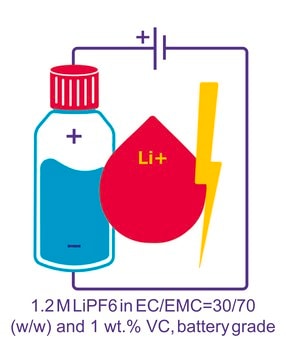934828
Lithium hexafluorophosphate solution
in ethylene carbonate and ethyl methyl carbonate with vinylene carbonate additive, 1.0 M LiPF6 in EC/EMC=30/70 (w/w) + 1 wt.% VC, battery grade
Sinónimos:
1.0 M LiPF6 in EC/EMC=30/70 (w/w) + 1 wt.% VC
About This Item
Productos recomendados
grade
battery grade
Quality Level
description
Application: Battery Manufacturing
form
(clear liquid)
greener alternative product characteristics
Design for Energy Efficiency
Learn more about the Principles of Green Chemistry.
sustainability
Greener Alternative Product
concentration
1.0 M (LiPF6)
impurities
≤100.0 ppm H2O
≤250.0 ppm KF
color
colorless to faint yellow
density
1.203 g/mL
application(s)
battery manufacturing
greener alternative category
SMILES string
F[P-](F)(F)(F)(F)F.[Li+]
InChI
1S/F6P.Li/c1-7(2,3,4,5)6;/q-1;+1
InChI key
AXPLOJNSKRXQPA-UHFFFAOYSA-N
¿Está buscando productos similares? Visita Guía de comparación de productos
General description
Application
signalword
Danger
Hazard Classifications
Acute Tox. 4 Oral - Eye Dam. 1 - Flam. Liq. 2 - Skin Corr. 1A - Skin Sens. 1 - STOT RE 1 Inhalation - STOT RE 2 Oral
target_organs
Bone,Teeth, Kidney
Storage Class
3 - Flammable liquids
wgk_germany
WGK 2
flash_point_f
69.8 °F
flash_point_c
21 °C
Certificados de análisis (COA)
Busque Certificados de análisis (COA) introduciendo el número de lote del producto. Los números de lote se encuentran en la etiqueta del producto después de las palabras «Lot» o «Batch»
¿Ya tiene este producto?
Encuentre la documentación para los productos que ha comprado recientemente en la Biblioteca de documentos.
Nuestro equipo de científicos tiene experiencia en todas las áreas de investigación: Ciencias de la vida, Ciencia de los materiales, Síntesis química, Cromatografía, Analítica y muchas otras.
Póngase en contacto con el Servicio técnico












